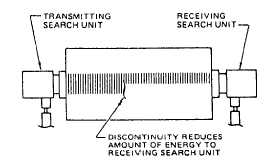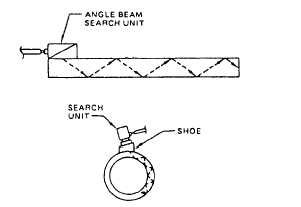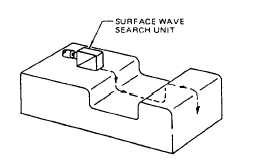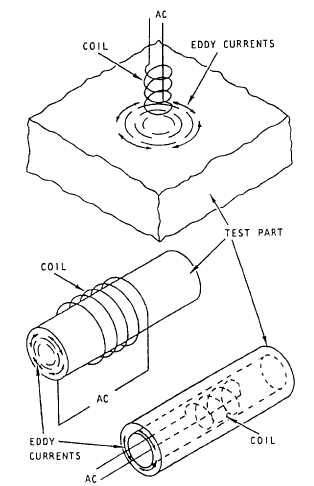Figure 15-13.—Through-transmission inspection.
Figure 15-14.—Angle-beam inspection.
Figure 15-15.—Surface-wave inspection.
inspection of cylindrical components, examination of
skins for cracks, and inspection of welds. Figure 15-14
shows typical angle-beam inspections.
SURFACE WAVE.—The surface-wave method
projects a beam of vibrations that travel along the
surface and just below the surface of the material. When
surface waves are used to inspect painted surfaces, you
should exercise caution during set up and interpretation
due to the possibility of surface reflection from scratches
and breaks in the painted surface. Surface-wave
inspections can be used in many field NDI applications
Figure 15-16.—Generation of eddy currents in various part con-
figurations.
involving surface cracks or slightly subsurface
discontinuities. On smooth surfaces, sound energy can
travel long distances with little energy loss. Surface
waves travel around curved corners, and they reflect at
sharp edges. Rough surfaces or liquid on the surface
attenuate surface waves so the area in front of the search
unit must be kept clear of couplant. Figure 15-15 shows
a typical surface-wave inspection.
Eddy Current Inspection
Eddy currents are electrical currents induced in a
conductor of electricity by reaction with a magnetic
field. The eddy currents are circular in nature, and their
paths are oriented perpendicular to the direction of the
applied magnetic field. In general, during eddy current
testing, the varying magnetic field(s) is/are generated by
an alternating electrical current (ac) flowing through a
coil of wire positioned immediately adjacent to the
conductor, around the conductor, or within the
conductor. Figure 15-16 shows eddy currents flowing in
various configurations.
15-11







